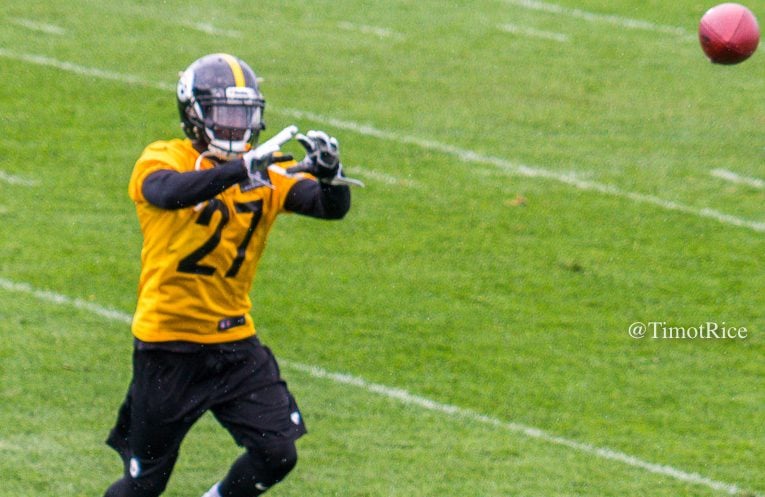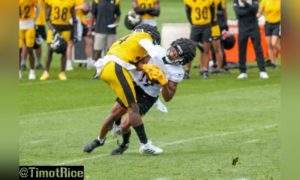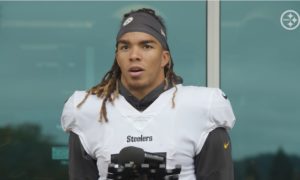It’s said a draft class can’t be fully graded until at least three years after the picks are made. That’s why after submitting grades for every Pittsburgh Steelers pick made in 2021, I began going back through and grading previous Steeler draft classes beginning with 2018. Today continues the fourth class in that exercise, with the Steelers’ second-round pick in the 2015 NFL Draft: Senquez Golson, a cornerback from Ole Miss.
This exercise follows the six viewpoints (listed below) for examining and re-grading a pick. Each of the first five viewpoints gets examined and assigned a letter grade, before taking that analysis and combining it into a final letter grade. Those five viewpoints comprise much of what goes into the draft grades consumed by so many every year after the draft.
Steelers’ Career: What did the player contribute to the team that drafted him?
NFL Career: Did the player make the pick look better in hindsight after leaving Pittsburgh?
Pick Value: Did the player outperform his draft slot? Did he fail to live up to the pick used on him?
Positional Value: Was the player the best player remaining at his specific position in the draft?
Other Options: Did any players go during the next round that were better selections?
Overall Grade: A final mark to denote whether the selection was an overall positive one, or one better spent elsewhere.
Each factor in a retrospective doesn’t apply evenly to every pick made; consider the grades weighted. For example, to return a high grade in pick value, a first-round pick should have a long and impactful career, while a later-round pick needs only a couple seasons as a back-up or modest contributor to be worth the selection used on him.
Some factors are universal, though. Whether picked first overall or 259th, there will always be other options on the board to compare the player to, and steals and reaches can come from any place in the draft.
Round 2, Pick 24: Senquez Golson, CB, Ole Miss
STEELERS & NFL CAREER: F
Injuries have affected the careers of many players profiled in these retrospectives thus far. But they straight up destroyed the career of Golson, an All-American cornerback and the first corner the team had selected in the top two rounds since Bryant McFadden in 2005. A zone coverage specialist who could play in the slot and bring in plenty of interceptions (he had 10 his final season at Ole Miss), Golson fit what the Steelers wanted and needed during a years-long quest to fix a failing secondary.
Too bad for all his promise, potential, and status as a second-round pick, Golson never saw the field in his NFL career. Every season, the corner failed to make it out of camp healthy, or without some kind of serious injury. His rookie year featured a season-ending shoulder injury in August. The following two years, he suffered a severe injury on the first day of practice in pads: A season-ending Lisfranc injury in 2016, and then a hamstring injury in 2017. The latter wasn’t season-ending, but it did end his Steeler career. Out of patience waiting to see him on the field, Pittsburgh released Golson during roster cutdowns.
Golson’s NFL career wasn’t far behind from its final chapter. Tampa Bay picked him up later in the year after his injury healed up, but Golson lasted just a week on the Bucs’ practice squad. His final NFL stint came with the Oakland Raiders, but he lasted just a little under two months on the offseason roster before the team released him.
PICK VALUE: F
You don’t want to heap blame on a player when sometimes injuries are just again him. But Golson is one of the worst values of a Day 2 pick in the last decade. He never saw the field, and spent an extremely limited time even on a practice field, suffering injuries in the first padded practice two of his three full seasons. Prior to Golson, the last player taken as high in the draft who never played an NFL game was Kenny Irons, a running back drafted by Cincinnati in 2007’s second round, 49th overall. Irons suffered an ACL injury as a rookie and never returned to the field.
Since, it has been a rare occurrence for the same to happen to a player. Not counting the 2020 class, who has only one year in the NFL, only two players taken as high have failed to see an NFL field: Christian Hackenberg, who went 51st to the New York Jets in 2016, and Malik McDowell, who went 35th to Seattle in 2017.
POSITIONAL VALUE: F
When you get outside the first round of the 2015 draft, the cornerback class is atrocious. Over 20 corners went in Rounds 2-7, and just a few became something of substance in the NFL. Leading the way is a name familiar to anyone who follows Pittsburgh or my Twitter feed, Steven Nelson. Drafted 98th by Kansas City, Nelson’s numbers the last two seasons after a fourth-year breakout in K.C. place him among the best cornerbacks in football. He remains a free agent as a lockdown starting option, after Pittsburgh released him for cap reasons this offseason.
P.J. Williams (78th, New Orleans) is in his sixth season with the Saints, never as a full-time starter but always as a versatile DB playing most snaps. Among players who stayed at corner, that’s about it. Just two names of lasting value. Look beyond them, and you have Darryl Roberts (247th, New England) who has started most of two seasons, and Josh Shaw (120th, Cincinnati), who started one season but just got back from an indefinite suspension for betting on games. Tye Smith (170th, Seattle) has been a depth corner for the Seahawks, and just signed with the Minnesota Vikings this month.
Quandre Diggs (200th, Detroit) is a star, but converted to safety. Bobby McCain (145th, Miami) did the same, and just signed with Washington after six years of being a main piece of the Dolphins secondary. Either could have boosted the value of a cornerback class that as top-heavy as you can get. Even if most of the players barely saw the field, that’s still more than what Pittsburgh got from Golson.
OTHER OPTIONS: F
The 2015 class wasn’t great for cornerbacks, but it sure was for running backs. In the round of picks following Golson, three different players went who showed starting potential. David Johnson (86th, Arizona) was an instant star and a second-year All-Pro before his career regressed over recent seasons. Tevin Coleman (73rd, Atlanta) showed strong flashes in five years with the Falcons before regressing last year with San Francisco. Duke Johnson (77th, Cleveland) never got handed the reins to be a true starter, but is one of the better pass-catching backs in the league, with over 40 receptions five of his six seasons.
Just as much value went at pass rusher during that span, too. Mentioned in yesterday’s Bud Dupree retrospective was Markus Golden (58th, Arizona), who has two double-digit sack seasons in his career. When you shift from a linebacker on the edge to an end, it gets even better. Danielle Hunter (88th, Minnesota) is a two-time Pro Bowler with two straight seasons of 14.5 sacks. Frank Clark (63rd, Seattle) comes with a lengthy history of off-field issues, but is a Pro Bowler the last two seasons.
And if your choice for the best player in the next 32 picks isn’t Hunter, it’s probably Tyler Lockett (69th, Seattle), who has two seasons of 1,000 receiving yards, hit 100 receptions last year, and has eight or more touchdowns the last three years. Further names taken include standout guard Ali Marpet (61st, Tampa Bay), another guard starter in A.J. Cann (67th, Jacksonville), and inside linebacker Jordan Hicks (84th, Philadelphia).
OVERALL GRADE: F
A team can try to predict players who are riskier bets to stay healthy, but no team is going to predict that a player will suffer serious and season-ending injuries in training camp each of his first three seasons. Golson’s career never got started because of those injuries, and when Pittsburgh couldn’t wait around any longer, other teams didn’t take a serious run at him. Injuries have helped turn some Steeler picks into misses over the last decade, but none have made a pick as big a miss as this one.






